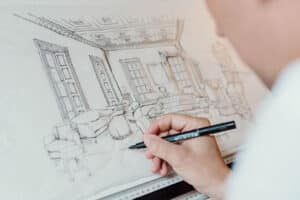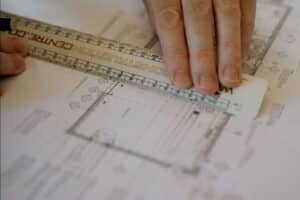Every building begins with a series of carefully considered details – the meeting of materials, the balance of structure, the interplay of form and function. For Tim Grove, Sibley Grove’s Architectural Design Director, this instinct for precision was honed long before he worked on large-scale projects. Trained first as a furniture designer and maker, Tim learned to see design at its most tactile and immediate, where every joint, fixing and surface finish matters.
Furniture: Architecture in Miniature
There are some fundamental similarities between furniture design and architecture. With some 3-D design, for example product design, the mechanisms of a product are often concealed within a casing or behind a façade. Furniture design is different in that it’s the elements like the backrest, seat, legs that are the piece. These are simple, primary elements that anyone can understand, which can come together in infinite ways. They are explicitly on show and as well as being functional, are an intrinsic part of the item’s design language and aesthetic. I like to think of furniture as architecture in miniature.
A chair’s ultimate test is its comfort, but it must also look beautiful in the context of its proposed setting. Even the most utilitarian piece, for example a plastic stacking school chair, must come together as a clean coherent design. In addition to the look of the piece, choices of materials, sustainability, build-ability, safety, efficient use of the materials in the production, how easy it is to clean and maintain, and robustness are the same considerations for both architecture and furniture design.
From Workshop to Architect’s Board
In the early days, I was a furniture maker operating out of my own small industrial workshop. A lot of design effort goes into the production side of things which feeds back into the final design. There are often many ways to shape the same piece of timber using different techniques and machines. How an item is built will depend on what tools and machines we have at our disposal and what scale we are building at. Is it a one-off bespoke piece, a larger number of the same pieces at scale, or a regular repeat order? A lot of design effort can go in to creating jigs and templates, and we need to work with tools and machines that are appropriate to the scale and repeatability of production. With repeat orders the production process in a small workshop often gets refined each time in terms of efficiency and execution.
Materiality and Practicality
The hands-on experience of building furniture also gives one a very clear understanding of materiality; the strength of a material and fittings and fixings and its weight and handling. It also gives an appreciation for how things fit together practically. As someone who has designed and built furniture, I am very conscious when producing an architectural drawing, of the people having to read and understand the drawings on a building site and handle the materials to achieve the details we are after, so if we can simplify the process we will.
This understanding of materiality, construction and build-ability underpins Sibley Grove’s approach to architectural design. This hands-on understanding helps me design buildings that are clear, buildable and considerate of the people constructing them. At Sibley Grove, design is never just about what you see. It’s about how something is made, how it functions over time, and how people interact with it. By marrying craftsmanship with technology, our ambition is to ensure that every project, whether a hotel refurbishment or a heritage restoration, is as technically sound as it is visually refined.
Tim Grove – Architectural Design Director, Sibley Grove




